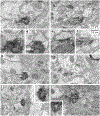Midline thalamic inputs to the amygdala: Ultrastructure and synaptic targets
- PMID: 30311651
- PMCID: PMC6347509
- DOI: 10.1002/cne.24557
Midline thalamic inputs to the amygdala: Ultrastructure and synaptic targets
Abstract
One of the main subcortical inputs to the basolateral nucleus of the amygdala (BL) originates from a group of dorsal thalamic nuclei located at or near the midline, mainly from the central medial (CMT), and paraventricular (PVT) nuclei. Although similarities among the responsiveness of BL, CMT, and PVT neurons to emotionally arousing stimuli suggest that these thalamic inputs exert a significant influence over BL activity, little is known about the synaptic relationships that mediate these effects. Thus, the present study used Phaseolus vulgaris-leucoagglutinin (PHAL) anterograde tracing and electron microscopy to shed light on the ultrastructural properties and synaptic targets of CMT and PVT axon terminals in the rat BL. Virtually all PHAL-positive CMT and PVT axon terminals formed asymmetric synapses. Although CMT and PVT axon terminals generally contacted dendritic spines, a substantial number ended on dendritic shafts. To determine whether these dendritic shafts belonged to principal or local-circuit cells, calcium/calmodulin-dependent protein kinase II (CAMKIIα) immunoreactivity was used as a selective marker of principal BL neurons. In most cases, dendritic shafts postsynaptic to PHAL-labeled CMT and PVT terminals were immunopositive for CaMKIIα. Overall, these results suggest that CMT and PVT inputs mostly target principal BL neurons such that when CMT or PVT neurons fire, little feed-forward inhibition counters their excitatory influence over principal cells. These results are consistent with the possibility that CMT and PVT inputs constitute major determinants of BL activity.
Keywords: CAMKIIα; RRID AB_2313606; RRID AB_2313686; RRID AB_2336656; RRID AB_2637031; RRID AB_447192; RRID RGD_734476; amygdala; electron microscopy; thalamus; tract-tracing.
© 2018 Wiley Periodicals, Inc.
Conflict of interest statement
Figures







References
-
- Amaral DG, Price JL, Pitkanen A, & Carmichael ST (1992). In Aggleton JP (Ed.), The amygdala: neurobiological aspects of emotion, memory, and mental dysfunction. (pp.1–66). New York, NY: Wiley-Liss.
Publication types
MeSH terms
Substances
Grants and funding
LinkOut - more resources
Full Text Sources

